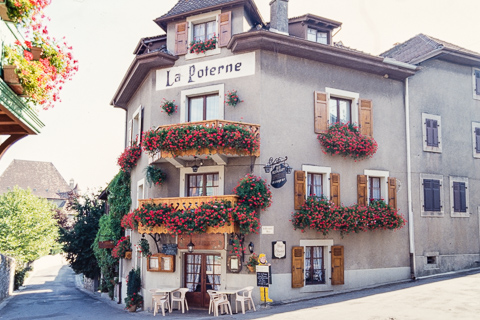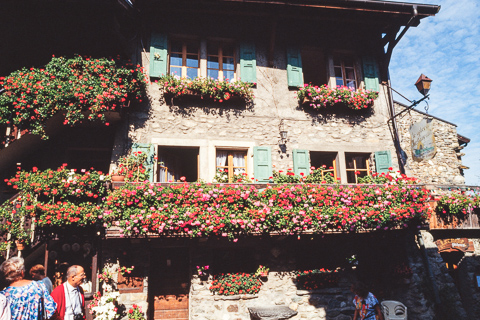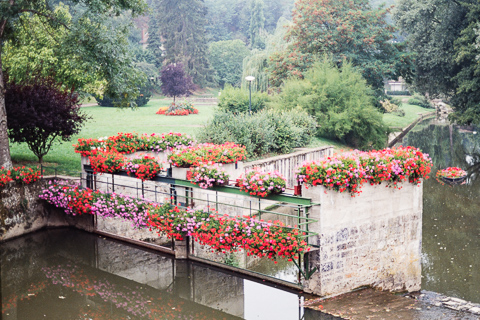Flower Cityscape Creation Movement
The creation of flower cityscape in France began in 1959.
The flower cityscape movement, which began at the invitation of the French Ministry of Tourism and was joined by 600 municipalities,
in 1972 it grew into a movement involving 7,000 municipalities under the semi-governmental CNFF (Committee for Decorating France with Flowers).
By 1990, it had become a major, established movement with the participation of 8,000 municipalities, accounting for 25% of the country.
The basic idea is as follows.
1. Make France the garden of Europe.
2. Give visitors the greatest welcome with flowers.
In many cities participating in the movement, it seems that they are aiming for the effect of revitalizing the city as a tourist attraction, but in fact, when looking at the improvement effect of flowers on the living environment, I am impressed by this wonderful movement.
Furthermore, while promoting the creation of a flower cityscape, communication between people in the city and between cities is becoming active. In other words, it also revitalizes the city. In addition, it can be said that France is characterized by the fact that the cityscape of flowers is actively created by the government rather than the private sector.
This movement has spread to neighboring countries. In the United Kingdom, the BBC
All the countries participating in the International Horticultural Association are now eligible to enter the international competition, which was started in France, the United Kingdom, Switzerland, Belgium and seven other countries with the aim of promoting international goodwill with flowers. Of course, Japan is also included. Above all, France is by far the best in the competition, and their city of international entry, which was selected through three stages of domestic selection, always occupies the top results. In France, the top prize-winning cities of the past competitions have been awarded the "Four Flowers" rating by the French government.
France's Yvoire, Annecy, Chatillon-sur-Charalonne, etc., which I visited, have all achieved excellent results in the flower competition in the past, and have been excluded from the future competition entry and are rated as four flowers instead. As shown in the Yvoire report photo, the city of four flowers has the right to display four flowers at the entrance. The four-flower signboard shows the pride of the city and has a great PR effect on tourism.
In particular, I will take up two examples of creating a cityscape of flowers that left an impression on me. At first, Yvoire (France) is a small town, but the density of flowers is outstanding. Next is Chatillon-sur-Charalonne (France), which promotes the beautification of the city efficiently, mainly in public places.
YVOIRE
Yvoire (France) has been a fishing village since the Middle Ages, but since it began to decorate itself with flowers in the 1960's, it has transformed into a tourist village as the most beautiful village on the shores of Lake Geneva. The vivid dress-up of flowers gives a strong impression to the medieval masonry building.
As a basis for achieving this, the government spends 15% of its annual budget on the maintenance of flowers and greenery. It is an amazing amount of about 50,000 yen per resident.
However, the volume of flowers in the city does not seem to be maintained solely by government investment. At the art shop, I was asked, "Would you like to see the garden?" Everyone seems to live proudly in their homes and gardens. With the help of the government, the cityscape of flowers is now being actively created by the autonomous action of the residents themselves. It is wonderful that the administration and the residents' consciousness of urban development are completely in agreement.Moreover, it is said that even if the four-flower rating is obtained, it will be downgraded (three-flower, two-flower) if efforts are not made to maintain it every year. It can be said that the consciousness of urban development that spends money and effort to maintain is growing, not just when making it. Although it is a small city with a population of only 450 people and the economic benefits of tourism will be great, I was really envious of such a beautiful environment and the people living there.
CHATILLON-SUL-CHALARONNE
Chatillon-sur-Charalonne (France) is also a small village with a population of 4000, but it has a long history as a sub-prefectural capital of Ain Province. It received a four-flower rating in 1965 and is also a pioneering city among the 60 four-flower cities currently in France. A very beautiful sycamore tree-lined road is arranged on the entrance of the city, and planters, flower beds, flower carts, etc. are decorated mainly in public places in the city.
Unlike Yvoire, the size of the city is large, so it is not possible to have flowers on the windowsills of every house, but effective flower installation is wonderful. In this city as well, the creation of a flower cityscape has become active as a tourism promotion. The river that flows through the city is also a tourist attraction, and the floodgates, the railings of the bridge, and the floating islands in the river are shown up with flowers. In addition, the city is promoting the development of the city by remodeling the ground level so that it can easily move around the city and unifying the design of the signboards of the city. Coupled with the flowers, it gives a strong impression of a very beautiful city.
The annual cost of purchasing flowers is 2 million francs (2.5% of the city budget), which is an investment of about 15,000 yen / year per resident. Flower boxes, planters lined up on the main street. A planter designed to firmly attach to the railings of a bridge. All of the city's show-ups, including the voluminous Ivy flower arrangements, were at the highest level of the city we visited. The season was also the best, and it became an unforgettable city as a city that taught me the beauty of flowers.
Conclusion
These two cityscapes perfectly embody the basic idea of the flower cityscape above. And I think that the basis of the success of the flower cityscape is not only the administrative action to beautify the environment, but also the efforts to gain the understanding and sympathy of the residents for the flower cityscape. When residents understand the goodness of their own city and act to maintain its value, a "comfortable" city where residents feel attachment and pride is realized. And the atmosphere of such a city will make visitors feel amenity.


